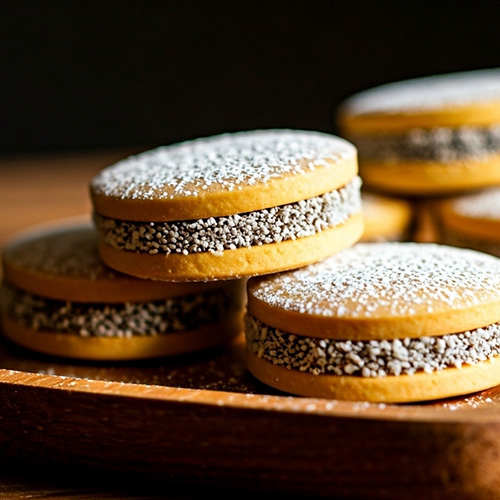Ingredients
Equipment
Instructions
Dough
- In a medium bowl, whisk together: Cornstarch, flour, baking powder, baking soda, and salt.In a large bowl, cream together: Butter and powdered sugar until pale and fluffy (2–3 minutes). Add yolks one at a time, mixing well after each. Mix in vanilla and lemon zest.Gradually add dry ingredients. Mix until just combined. The dough should be soft but not sticky.Shape into a disk, wrap in plastic, and chill for 30 minutes.
- Roll & Cut:Preheat oven to 350°F (175°C).Roll dough on a floured surface to about 1/4 inch (6 mm) thick. Cut into rounds using a 2-inch cookie cutter.Place on parchment-lined baking sheets, about 1 inch apart.
- Bake:Bake for 10–12 minutes, until the cookies are just set but not browned.Let cool on the sheet for 5 minutes, then transfer to a wire rack.
- Assemble:Once completely cool, spread about 1 tablespoon of dulce de leche onto the flat side of half the cookies. Sandwich with the other half and press gently.
Notes
Don’t overwork the dough: Mix just until combined to keep the cookies tender and crumbly.
Chill the dough: This prevents spreading and makes rolling easier. You can chill it longer if needed—just let it sit out a few minutes to soften slightly before rolling.
Roll evenly: Aim for consistent thickness (~¼ inch) to ensure even baking. Use rolling pin rings or guides if you have them.
Cornstarch is key: It’s what gives alfajores their melt-in-your-mouth, delicate texture. Don’t substitute with more flour.
Lemon zest adds authenticity: It gives the dough a traditional hint of citrus that's typical in Argentine versions, but you can skip it for a more neutral vanilla flavor.
Butter temperature matters: Use room temperature butter for easier creaming and better texture.
Don’t brown them: Alfajores should be pale, soft, and just set when you remove them from the oven. Overbaking makes them dry.
Don’t overfill: The dulce de leche will spread slightly when you sandwich the cookies, so about 1 tablespoon is perfect.
